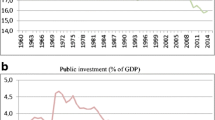Abstract
Our data on investment in Central and Eastern European economies reveal that, though investment rates were typically high in the 1970s, the marginal efficiency of investment was low. Investment shares begun to decline in the 1980s, before the collapse of the communist system, but there was some recovery in most countries after transition. We use the Kalman filter framework to test for convergence in investment rates. We find some evidence of convergence in Central European countries – former Czechoslovakia, Poland and the countries of the former Yugoslavia. For the remainder of the socialist bloc, however, we were unable to isolate convergence in investment shares.
Similar content being viewed by others
References
Aslund, A., Boone, P. and Johnson, S. (1997), ‘How to stabilize: lessons from post-communist countries’, Brookings Papers on Economic Activities 0(1), 217–291.
Barr, N. (1995), Labour Markets and Social Policy in Central and Eastern Europe, Washington, D.C., World Bank.
Barro, R. J. and Sala-i-Martin, X. (1991), ‘Convergence across states and regions’, Brookings Papers on Economic Activity 1, 107–182.
Baumol, W. J. (1986), ‘Productivity growth, convergence, and welfare: what the long-run data show’, American Economic Review 76, 1072–1085.
Bernard, A. B. and Durlauf, S. N. (1995), ‘Convergence in international output’, Journal of Applied Econometrics 10, 97–108.
Bernard, A. B. and Durlauf, S. N. (1996), ‘Interpreting tests of convergence hypothesis’, Journal of Econometrics 71,161–173.
Bernard, A. B. and Jones, C. I. (1996), ‘Productivity across industries and countries: Time series theory and evidence’, Review of Econometrics and Statistics 78, 135–146.
Blanchard, A. B. et al. (1990), Reforms in Eastern Europe, Cambridge, M.I.T. Press.
Boone, P., Gomulka, S. and Layard, R. (1998), Emerging from Communism: Lessons from Russia, China and Eastern Europe, Cambridge, M.I.T. Press.
Canova, F. and Marcet, A. (1995), ‘The poor stay poor: Non-convergence across countries and regions’, Discussion Paper No. 1265, Centre for Economic Policy Research, London.
De Melo, M., Denizer, C., Gelb, A. and Tenev, R. (1997), ‘Circumstances and choice: the role of initial conditions and policies in transition economies’, World Bank, International Finance Corporation.
Durlauf, S. and Johnson, P. A. (1995), ‘Multiple regimes and cross-country growth behaviour’, Journal of Applied Econometrics 10, 365–384.
Dyker, D. A., 1984, Investment Cycles in Socialist Economies, Cambridge, Cambridge University Press.
EBRD Transition Reports, various issues.
Ellman, M. (1988), Socialist Planning, 2nd edition, Cambridge University Press, Cambridge, UK.
Estrin, S., Urga, G. and S. Lazarova (1999), ‘Testing for ongoing convergence in transition economies. Central and Eastern Europe: 1970- 1998’, mimeo, London Business School and City University Business School, London.
Evans, P. and Karras, G. (1991), ‘Convergence revisited’, Journal of Monetary Economics 37, 249–265.
Evans, P. and Karras, G. (1997), ‘Do economies converge? Evidence from a panel of US. states’, Review of Economics and Statistics 79, 384–388.
Hall, S., Robertson, D. and Wickens, M. (1992), ‘Measuring convergence of the EC economies’, Discussion Paper no. DP 1–92, Centre for Economic Forecasting, London Business School, London.
Hall, S., Robertson, D. and Wickens, M. (1993), ‘How to measure convergence with an application to the EC economies’, Discussion Paper no. DP 19–93, Centre for Economic Forecasting, London Business School, London.
IMF, World Bank, OECD, EBRD, (1991), A Study of the Soviet Economy, Vol. 1, 129–279.
Islm, N. (1995), ‘Growth empirics: A panel data approach’, Quarterly Journal of Economics 110, 1127–1170.
Kornai, J. (1985), Highways and Byways, Cambridge, Cambridge University Press.
Lee, K., Pesaran, H.M. and Smith, R. (1996), ‘Growth and convergence in a multi-country empirical stochastic Solow model’, Discussion Paper no. 96/14, Department of Economics, Faculty of Social Sciences, University of Leicester, Leicester.
Marer, P., Arvay, J., O'Connor, J., Schrenk, M. and Swanson, D. (1992), Historically Planned Economies: A Guide to the Data, Washington DC, The World Bank.
Popov, V. (1998), ‘Investment in transition economies: factors of change and implications for performance’, Journal of East-West Business 4, 47–98.
Popov, V. (1999), ‘Investment, restructuring and performance in transition economies’, Postcommunist Economies 11(4), 445–462.
Quah, D. (1993), ‘Galton's fallacy and tests of the convergence hypothesis’, Scandinavian Journal of Economics 94(4), 427–443.
Quah, D. (1996), ‘Empirics for economic growth and convergence’, European Economic Review 40, 1353–1375.
St. Aubyn, M. (1995), Evaluating Tests for Convergence of Economic Series Using Monte-Carlo Methods with an Application to Real GDP's per Head, Ph.D. Thesis, London Business School, London.
Author information
Authors and Affiliations
Corresponding author
Rights and permissions
About this article
Cite this article
Estrin, S., Lazarova, S. & Urga, G. Convergence in Transition Countries – Focus on Investment: Central and Eastern Europe, 1970–1996. Economics of Planning 34, 215–230 (2001). https://doi.org/10.1023/A:1011810922630
Issue Date:
DOI: https://doi.org/10.1023/A:1011810922630




